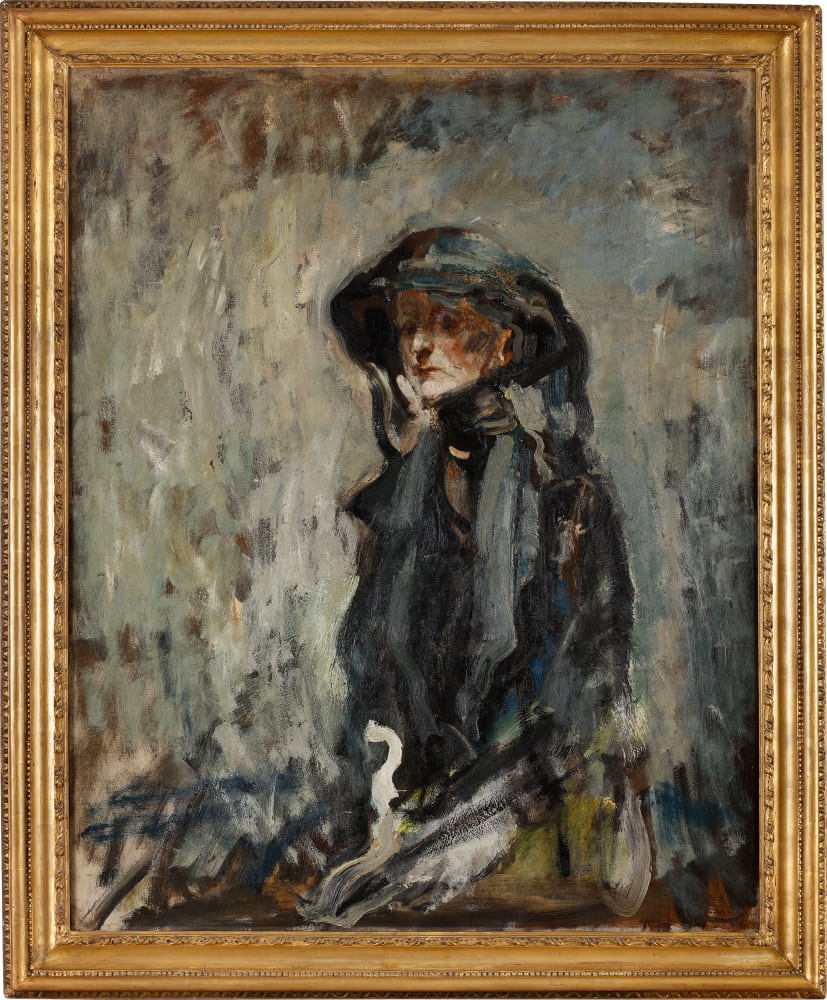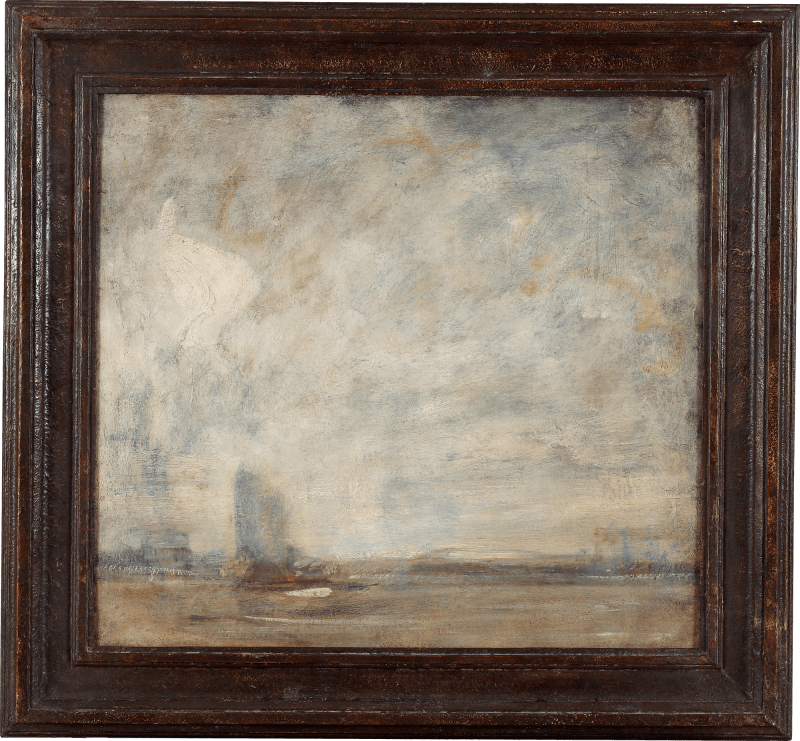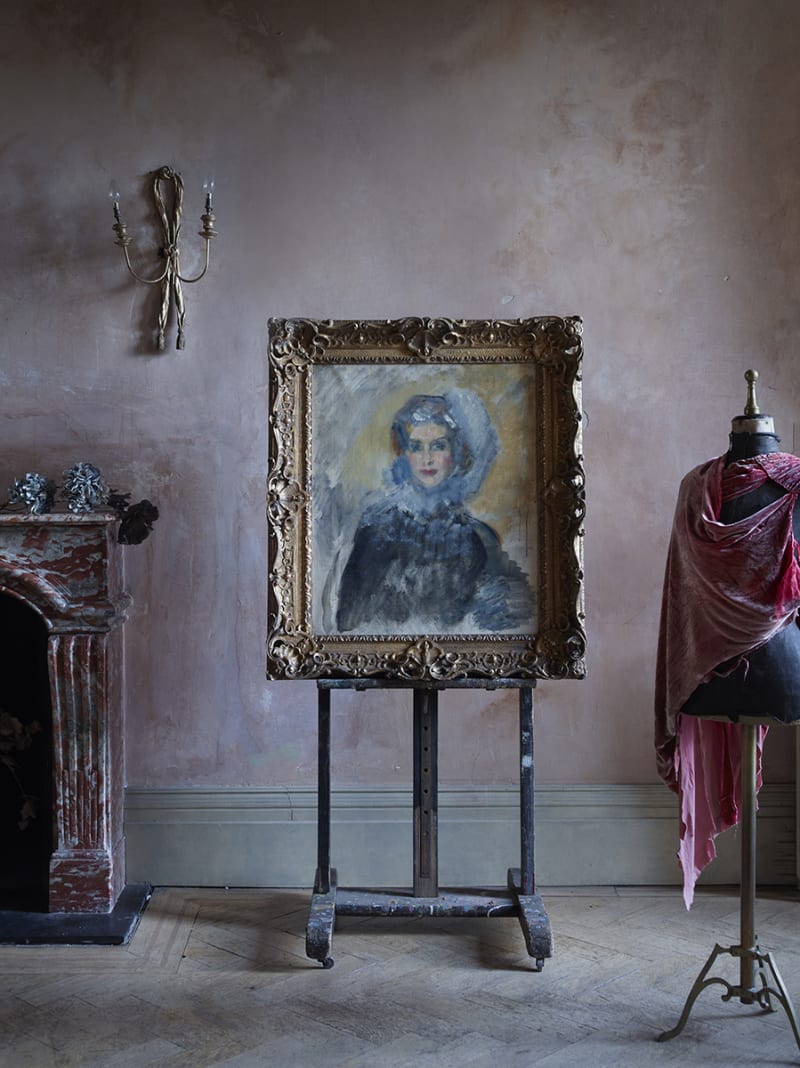

Ambrose McEvoy
(1877-1927) Seated WomanProvenance
Private Collection.
As is common in McEvoy’s later oils, his application of paint towards the lower half becomes increasingly abstracted.
Gestural swathes of thick paint govern the subject of this pensive portrait. Unusually for McEvoy, the sitter’s eyes are not the focal point; instead her gaze is directed downwards in a rather meditative manner. Although the sitter is unknown, McEvoy explores her character through his attentive handling and renders her introspective pose and facial expressions with curiosity and kindness. As is common in McEvoy’s later oils, his application of paint towards the lower half becomes increasingly abstracted. Whilst the blue tones appear sombre, the loose brushstrokes inject energy; McEvoy establishes an exquisite equilibrium between contemplative introspection and zestful outward expression.
Biography
Ambrose McEvoy demonstrated his exceptional artistic abilities from a young age. Encouraged by his father, Captain Charles Ambrose McEvoy, and inspired by his father’s great friend, James Abbott McNeill Whistler, McEvoy enrolled at the Slade School of Fine Art at the age of sixteen.[1] He studied at the Slade between 1893 and 1898 and afterwards rented a small flat in...
Gestural swathes of thick paint govern the subject of this pensive portrait. Unusually for McEvoy, the sitter’s eyes are not the focal point; instead her gaze is directed downwards in a rather meditative manner. Although the sitter is unknown, McEvoy explores her character through his attentive handling and renders her introspective pose and facial expressions with curiosity and kindness. As is common in McEvoy’s later oils, his application of paint towards the lower half becomes increasingly abstracted. Whilst the blue tones appear sombre, the loose brushstrokes inject energy; McEvoy establishes an exquisite equilibrium between contemplative introspection and zestful outward expression.
Biography
Ambrose McEvoy demonstrated his exceptional artistic abilities from a young age. Encouraged by his father, Captain Charles Ambrose McEvoy, and inspired by his father’s great friend, James Abbott McNeill Whistler, McEvoy enrolled at the Slade School of Fine Art at the age of sixteen.[1] He studied at the Slade between 1893 and 1898 and afterwards rented a small flat in Danvers Street, Chelsea, where he lived and worked.
McEvoy soon established himself as a gifted genre painter; he explored rolling landscapes and intimate interior scenes whilst attracting attention from wealthy patrons and collectors. During the mid-1910s, McEvoy ventured increasingly towards portraiture and the demand for his portraits rose concurrently.
In 1915 he exhibited his famous work Madame at the National Portrait Society and the following year he was commissioned to paint portraits of several prominent society figures including Consuelo, Duchess of Marlborough and Maude Baring. These high-profile commissions gained McEvoy considerable recognition and firmly established his position as a fashionable portrait painter.
However, as with many artists, his career was interrupted by the First World War and in 1918 he was attached to the Royal Naval division as a war artist and posted to the Western Front and the North Sea.[2] Whilst there, McEvoy painted a number of portraits of military commanders, many of which are now in the collection at the Imperial War Museum.
In the years following the First World War, McEvoy’s career and reputation grew from strength to strength and he was soon heralded as one of the most successful and fashionable English society portrait painters of his day. His innovative style and florid methods endeared an emerging generation of young, wealthy and liberal-minded patrons. His famed depictions of human character and beauty, particularly of women, became sought after and he maintained an illustrious list of clients spread between the United Kingdom and America, where he was represented for a period by the most celebrated international art dealer of the day, Lord Duveen.[3]
However, this youthful success was to take its toll on McEvoy and he died in 1927, aged forty-nine. Critics writing shortly after his death were in little doubt as to the significance of his work; ‘the most refined aspect of early twentieth century society will live on in his work, and that alone ensures his position in history’.[4]
To this day, he has become famed for his depiction of women. In his obituary in The Times he was praised for his ability to paint female subjects in a manner that was both visually appealing, but also bespoke the profundity of his ‘thoughts about human beauty, particularly feminine beauty’.[5]
[1] Akers-Douglas, E. A., Hendra, L. (ed.), (2019) Divine People: The Art & Life of Ambrose McEvoy. London: Paul Holberton Publishing, p.28.
[2] Akers-Douglas, E. A., Hendra, L. (ed.), (2019) Divine People: The Art & Life of Ambrose McEvoy. London: Paul Holberton Publishing, p.24.
[3] Akers-Douglas, E. A., Hendra, L. (ed.), (2019) Divine People: The Art & Life of Ambrose McEvoy. London: Paul Holberton Publishing, p.176.
[4] (1928) 'Ambrose McEvoy', Country Life. 28 January, Vol. 13, No. 1619, p. 106.
[5] (1927) 'Mr. Ambrose McEvoy', The Times. 5 January, p. 12.









